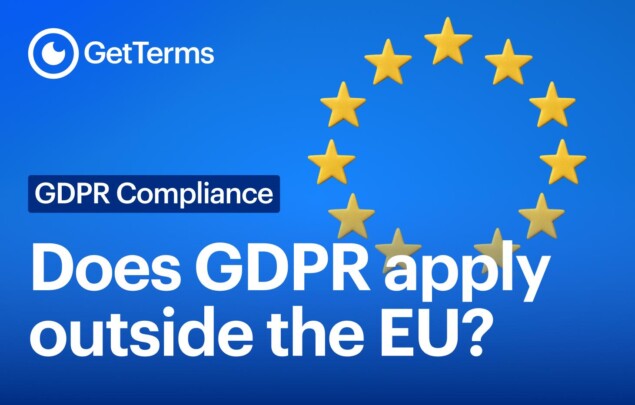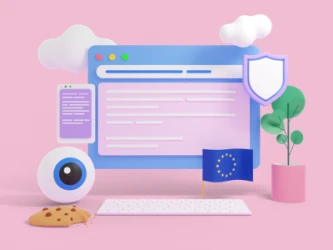Does the GDPR apply to businesses outside the EU?
Find out whether the GDPR applies to your business, even if you're not in the EU.

Create a GDPR-ready Privacy Policy, Terms & Cookie Banner in under 5 minutes.

If your business is subject to the California Consumer Protection Act CCPA, here’s eight things your website needs in order to be compliant.
Sort your CCPA compliance today!
Get StartedIf you’re subject to the CCPA, you’ll need to display a privacy policy that provides a detailed explanation of your business’s privacy practices and informs users of their privacy rights along with how to exercise them. Your privacy policy must be linked from your homepage, ideally in the footer of your website. For mobile apps, it can be on your download page or in your app’s settings menu.
If your business is subject to the CCPA, you’ll need to provide your users with a ‘notice at collection’ prior to or at the point of collecting personal information. Given http cookies collect Unique Personal Identifiers, which falls under the CCPA’s definition of personal information, if your website uses cookies for marketing or analytics, you’ll need to provide your notice the moment a user enters your website. We recommend that you use a cookie consent banner generator to do this.
Your notice at collection will need to include a link to your company’s privacy policy, a list containing the different categories of personal information your business collects at that point, and the purpose each category is used for, e.g. for performance cookies (used by Google Analytics) the purpose would be “to help us understand how our website is being used”.
In cases where you need to collect a category of personal information that isn’t disclosed in your original notice at collection, e.g. in a contact form, you’ll need to provide an additional notice at the time customers are submitting the form.
If your business sells consumers’ personal information, then your notice at collection will also need to include a link to your Do Not Sell or Share mechanism (discussed below).
If your business is subject to the CCPA, and sells or shares personal information, you’ll need a mechanism that allows your users to opt out of the sale or sharing of their personal information – This can be done with a form or toggle – see Microsoft’s do not sell or share my personal information page. The mechanism must not require users to create an account to submit an opt-out request and must be linked from your website’s homepage, ideally in the header or footer.
If you use or disclose sensitive personal information for purposes other than providing the services or goods your customers expect of you, you’ll need a mechanism to allow your customers to limit your use of their sensitive personal information – one of their rights under the CCPA. This mechanism should be linked to from your homepage, ideally your footer.
If a fitness app collects it’s users’ location data to help them track the distance they run each week, this aligns with the expected purpose of that sensitive data. However, if the app’s team sells that data to advertising companies to target users with ads for businesses in areas they frequently run, this constitutes using sensitive information for an unexpected purpose.
Instead of providing two separate opt out mechanisms for opting out or limiting data use, you can opt to use a single, clearly labelled link on your homepage that allows consumers to easily opt out of the sale or sharing of their personal information and to limit the use or disclosure of their sensitive personal information from one page. A great example of a “Manage Privacy Choices” page, is Microsoft’s third-party ad settings page.
If you choose this option, your link must be labelled either “Your Privacy Choices” or “Your California Privacy choices,” and shall include the following opt-out icon adjacent to the title.
![]()
If your business is subject to the CCPA, you’ll need to provide at least two methods for consumers to submit requests to know, delete, and correct their personal information. At least one method must be a toll-free telephone number, and if you have a website, one method must be through your website (e.g., a form or via a provided email address). If you operate exclusively online and have a direct relationship with consumers (as opposed to B2B), you only need to provide an email address for these requests. We recommend providing your contact details with instructions on how users can exercise their consumer rights from within your privacy policy.
If you are subject to the CCPA, you’ll need to make sure your website treats user-enabled global privacy controls, like the GPC, as a valid opt out requests.
A Global privacy control (GPC) – sometimes referred to as universal opt-out preference signal – is a tool that enables users to globally opt-in or opt-out of the processing, sharing or selling of their personal information. Users can setup a GPC with specific browsers and browser extensions.
All of your privacy notices and consent mechanisms are required to be reasonably accessible to consumers with disabilities, following generally recognised industry standards such as WCAG 2.1 for online content. Remember that PDFs are not always accessible, and that your consent banner will need to be readable by screen readers.